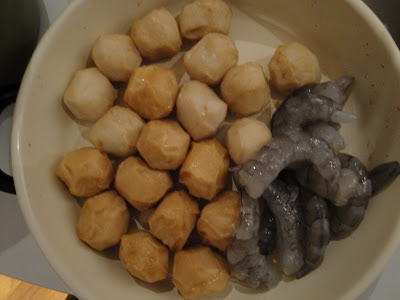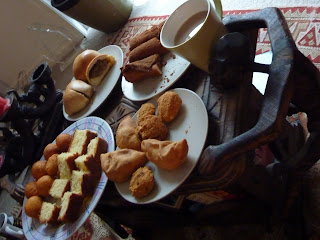The whole reason for the Toronto foodie post series is because of the people you see to your left. I went to Toronto to see Thanu and Sabesan get married. They were married in traditional Tamil Hindu style. They married for love.
Every culture I have encountered has an understanding about the linkage between food and love. It can be an expression of voodoo seduction between lovers, the nurturing demonstration of a loving parent, the happy medium at a meeting of friends, or the subject of a charitable act between strangers.
All I'm saying is that most of us can tell when food was cooked with love. It just tastes different. I had a friend who was a professional baker. She swore her bread always failed to rise or bake properly if she tried to bake after fighting with her lover. Maybe the bread just knew.
As per Hindu tradition, no meat or alcohol was served at Thanu and Sabesan's wedding feast. Meat and alcohol have long been considered to be things that pollute in the South Asian Hindu tradition. We were treated to a lovely vegetarian spread after what was maybe the shortest and most punctual Hindu wedding I've ever cried at. We were sent home with sweet little boxes of palaharams - Tamil sweetmeats. These were all made by hand by the women of the groom's and bride's family.
After the wedding, Sujith, Shanthi and my sisters decided to go to Sujith's family home for tea. We stopped at the Sri Lankan Quality Bakery in Markham. We happily bought up a lot of nice things for a proper Sri Lankan Tamil tea.
From the top right, moving clockwise: mutton rolls, masala vadai and fish patties, butter cake and panakai paniyaarum, and finally, fish buns. Delish. All in all, an excellent accoutrement for a fierce conversation about ethnicity and politics.
The newly married couple rashly promised to cook lunch for Shanthi, Sujith and me in their squeaky new apartment a scant two days after their marriage. It was actually quite an honour to be invited for lunch as this was the very first meal they cooked together in their new home. I arrived uncharacteristically early and watched the two of them cook together.
She chopped tomatoes for the tomato, red onion, coriander and green chili salad.

He industriously peeled hardboiled eggs and tended to the chicken masala on the stove.
As I idly sipped on mango juice mixed with perrier and watched them cook, my eye fell on a virgin jar of tamarind.
Tamarind is an amazing thing. You can make candy with it, shine brass with it, heal wounds with it, cook tasty curry with it, eat its green sour fruit from the tree, and as you see here, make a paste out of it for cooking purposes.
I'm not sure why Tamils never popped out an equivalent of George Washington Carver to do for tamarind what George did for peanuts.
Sabesan and Thanu cooked a lovely lunch that included the hardboiled eggs, spinach keera, tomato salad, rice, eggplant curry and ...
... a delectable chicken masala. Here's a recipe for Tamil love food.
 Tamil Style Chicken Masala
1 pound of chicken cut into 2 inch square pieces
1 large onion chopped finely
2 tomatoes chopped into 1 inch dice
7 - 8 garlic cloves coarsely chopped
3 inch piece of garlic, peeled and finely chopped
1 or 2 dried red chilis
3 green chilis chopped into1/2 inch rounds
2 tablespoons vegetable oil
1 teaspoon red chili powder
1 rounded teaspoon coriander powder
1/2 teaspoon ground cinnamon
1 teaspoon garam masala
1/2 teaspon turmeric powder
1/2 teaspoon cumin powder
1/4 teaspoon cumin seeds
6 - 7 curry leaves
1/2 teaspoon black mustard seeds
reserve Jaffna/Sri Lankan style curry powder
1 tablespoon of curd or Balkan style yoghurt
Salt - as per your taste
Tamil Style Chicken Masala
1 pound of chicken cut into 2 inch square pieces
1 large onion chopped finely
2 tomatoes chopped into 1 inch dice
7 - 8 garlic cloves coarsely chopped
3 inch piece of garlic, peeled and finely chopped
1 or 2 dried red chilis
3 green chilis chopped into1/2 inch rounds
2 tablespoons vegetable oil
1 teaspoon red chili powder
1 rounded teaspoon coriander powder
1/2 teaspoon ground cinnamon
1 teaspoon garam masala
1/2 teaspon turmeric powder
1/2 teaspoon cumin powder
1/4 teaspoon cumin seeds
6 - 7 curry leaves
1/2 teaspoon black mustard seeds
reserve Jaffna/Sri Lankan style curry powder
1 tablespoon of curd or Balkan style yoghurt
Salt - as per your taste
Method:
1. Heat the oil in a deep cooking pan over a medium to high heat. Add the black mustard seeds. When they start popping, throw in the red chili, cumin seeds and curry leaves. If you have fennel seeds, chuck in about a 1/4 teaspoon for bit more flavour. Don't break the dried chilis unless you like hot curry.
2. Reduce the heat to medium. Add the onion and fry until translucent. Add the ginger and garlic and fry until everything is well browned. Be brave. Allow your onions to turn a brownish colour. This is key in most Tamil curry making. If you like your masala spicy, add your green chilis now. Add a small quantity of salt (1/4 teaspoon).
3. Turn the heat up and add the chicken pieces, add turmeric powder and another 1/4 of salt. Turmeric must be treated almost like a raw vegetable and cooked to develop its flavour. Add the rest of your powdered spices: coriander, cinnamon, cumin, and garam masala. Fry the spices well but take care not to burn them. If need be, add a tiny bit of water.
4. After no more than 3 minutes, add the chopped tomatoes and mix until the chicken is gloriously coated in masala. If you didn't throw your green chili in earlier, add it in now. Add the curd/yoghurt and two cups of water to the pot.
5. Turn the heat down to medium. Let the masala cook for 15-20 minutes with the lid on. Stir the masala once in a while.
6. When the chicken is almost done cooking (the time for this will depend on your chicken, your stove and your pot), remove the lid and raise the heat. The object is to evaporate all excess water so that you end up with a lovely dry curry
7. Lower the heat when the gravy level drops, and do your level best to ensure the curry doesn't scorch. Some of my friends prefer more gravy with their masala, so if you're a gravy lover, don't feel pressured to cook the masala all the way down. Near the end of the cooking, test again for salt and for curry level. If you need more pow, add a bit more curry powder and cook for a few minutes more.
Note: I've read some blogs written by people who insist that true South Asians don't use curry powder. I resent that. Having lived among Tamils, and grown up with Sri Lankan Tamils, I can assure you that we use curry powder. Not all curry powders are created alike. Buy a good one and be wary of the sorts that are cut with rice flour or are made with spices that should have been thrown away. Ditto for your spices. Use good quality spices that haven't been sitting on a shelf for ages. Your taste buds will love you for it.



















































